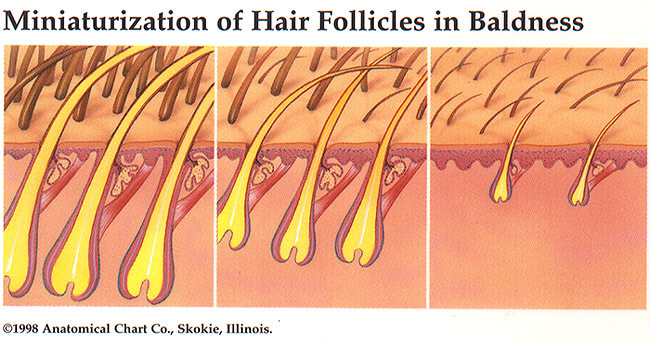The Role of Miniaturization in Hair Loss: Understanding the Process
Miniaturization is a key concept in understanding hair loss, especially when it comes to conditions like androgenetic alopecia (commonly known as male or female pattern baldness). It refers to the gradual shrinking of hair follicles over time, leading to thinner, shorter, and less pigmented hairs.
What is Miniaturization?
Miniaturization occurs when hair follicles shrink due to various factors, most notably the presence of dihydrotestosterone (DHT), a hormone derived from testosterone. This process involves the hair follicles transitioning from producing thick, healthy hairs to producing fine, weak strands that are often almost invisible.
Over time, the affected follicles may eventually stop producing hair altogether, resulting in noticeable thinning or bald spots.
The Role of DHT
DHT is a potent androgen that binds to receptors in hair follicles, particularly those on the scalp. In genetically susceptible individuals, DHT causes the follicles to miniaturize. The scalp hair follicles in these individuals are more sensitive to DHT, which leads to the shortening of the hair growth cycle and the weakening of hair strands.
This process generally follows a predictable pattern, starting with a gradual thinning at the crown and temples before progressing to larger bald patches.
The Hair Growth Cycle and Miniaturization
The hair growth cycle consists of three main phases:
In miniaturization, the anagen phase shortens, while the telogen phase lengthens, leaving hair in a prolonged resting state. As the follicle shrinks, it produces progressively thinner and shorter hairs, eventually leading to the cessation of hair production altogether.
Is Miniaturization Reversible?
The good news is that miniaturization can sometimes be reversed or slowed down with appropriate treatment. Medications like finasteride (which inhibits DHT production) and minoxidil (a topical treatment that stimulates hair growth) can help prevent further follicle shrinkage and encourage thicker hair regrowth.
In some cases, hair restoration procedures such as hair transplants may also be effective in restoring lost hair by transplanting healthy, non-miniaturized follicles to thinning or balding areas.
Tip - we use other medications and processes to maximize your DHT blocking, also we have TrichoTest.
Conclusion
Miniaturization is a crucial process in the development of hair loss, and understanding it is key to effective treatment. Early intervention, whether through medication, lifestyle changes, or medical procedures, can help slow the progression of hair thinning and promote healthier, thicker hair growth. If you're concerned about hair loss, consulting Dr Young can provide a tailored approach to managing and potentially reversing the effects of miniaturization.
Book in for the most advanced management and plan.
Miniaturization is a key concept in understanding hair loss, especially when it comes to conditions like androgenetic alopecia (commonly known as male or female pattern baldness). It refers to the gradual shrinking of hair follicles over time, leading to thinner, shorter, and less pigmented hairs.
What is Miniaturization?
Miniaturization occurs when hair follicles shrink due to various factors, most notably the presence of dihydrotestosterone (DHT), a hormone derived from testosterone. This process involves the hair follicles transitioning from producing thick, healthy hairs to producing fine, weak strands that are often almost invisible.
Over time, the affected follicles may eventually stop producing hair altogether, resulting in noticeable thinning or bald spots.
The Role of DHT
DHT is a potent androgen that binds to receptors in hair follicles, particularly those on the scalp. In genetically susceptible individuals, DHT causes the follicles to miniaturize. The scalp hair follicles in these individuals are more sensitive to DHT, which leads to the shortening of the hair growth cycle and the weakening of hair strands.
This process generally follows a predictable pattern, starting with a gradual thinning at the crown and temples before progressing to larger bald patches.
The Hair Growth Cycle and Miniaturization
The hair growth cycle consists of three main phases:
- Anagen (growth phase)
- Catagen (transition phase)
- Telogen (resting phase)
In miniaturization, the anagen phase shortens, while the telogen phase lengthens, leaving hair in a prolonged resting state. As the follicle shrinks, it produces progressively thinner and shorter hairs, eventually leading to the cessation of hair production altogether.
Is Miniaturization Reversible?
The good news is that miniaturization can sometimes be reversed or slowed down with appropriate treatment. Medications like finasteride (which inhibits DHT production) and minoxidil (a topical treatment that stimulates hair growth) can help prevent further follicle shrinkage and encourage thicker hair regrowth.
In some cases, hair restoration procedures such as hair transplants may also be effective in restoring lost hair by transplanting healthy, non-miniaturized follicles to thinning or balding areas.
Tip - we use other medications and processes to maximize your DHT blocking, also we have TrichoTest.
Conclusion
Miniaturization is a crucial process in the development of hair loss, and understanding it is key to effective treatment. Early intervention, whether through medication, lifestyle changes, or medical procedures, can help slow the progression of hair thinning and promote healthier, thicker hair growth. If you're concerned about hair loss, consulting Dr Young can provide a tailored approach to managing and potentially reversing the effects of miniaturization.
Book in for the most advanced management and plan.
